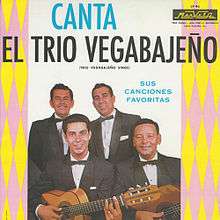Trio Vegabajeño
| Trio Vegabajeño | |
|---|---|
 One of many compilation albums. In this cover, one of their best line-ups: (from left to right) Benito de Jesús, Jorge Hernandez, Fernandito Alvarez and Pepito Maduro. | |
| Background information | |
| Origin | Vega Baja, Puerto Rico |
| Genres | bolero, danza, waltz, tango, guaracha, Puerto Rican folk |
| Years active | 1943-1980, 1986 |
| Labels | RCA, Marvela, Borinquen, Patty Records, Tecca Records, Ansonia |
| Associated acts | Alpha IV, Danny Rivera |
| Past members |
Fernandito Alvarez Benito de Jesús Octavio González Pepito Maduro Jorge Hernandez Tatin Vale Rafael Scharron Ricardo Feliú Rubén Maldonado Nacho Carrasquillo Monchito Monge Guillermo Rivera Luis Diaz |
Trio Vegabajeño was a legendary Puerto Rican popular music trio that existed from 1943 to the early 80s. This group marked an era of popular music in Puerto Rico. When trios were very popular in the Americas, Trio Vegabajeño was considered the ambassadors from Puerto Rico.
Vegabajeño is the demonym for people of the town of Vega Baja.
Eventually they were recognized as the National Trio of Puerto Rico[1] and on October 26, 1996 a monument was inaugurated in Vega Baja.
History
Trio Vegabajeño was informally formed in 1943 at the Tortuguero Military Camp of Vega Baja by Fernandito Álvarez who gathered a few co-workers (Octavio González and Benito de Jesús) to put together a few musical numbers. A friend, Rafael Quiñones Vidal, came up with the name for the trio. Shortly after they recorded their first song "Llanto de mar". At the time only Fernandito Alvarez and Benito de Jesus did both vocals and guitar while Octavio González only played guitar.
In 1945 Octavio González was recruited by the US Army and the trio brought Pepito Maduro, also a singer, as the replacement. The group now had an all singers line-up and became pioneers of this new style. During this line-up Guillermo Venegas Lloveras composed their theme song Tema - Trío Vegabajeño in which aside from describing the town of Vega Baja they also state what town is each one from:
[Fernandito] "Yo soy de Vega Baja (I am from Vega Baja)
[Benito] Barceloneta es mi pueblo (Barceloneta is my town)
[Pepito] Humacao fue mi cuna (Humacao was my cradle)..."
Although being a trio, the group became a quartet in 1952 when Jorge Hernandez (requinto player) joined the group. They didn't change the name of the group. This was one of their most successful line-up and even though was not the original, it was sometimes referred to as the "original" or "authentic" line-up.[2]
After the departure of Jorge and Benito, the trio had different line-ups.
The only living member of the quartet line-up (1952–65) is Jorge Hernandez. In 2002, the group was inducted into the International Latin Music Hall of Fame.[3]
En Mi Viejo San Juan
 |
Trio Vagabajeño "En mi Viejo San Juan"
A 17 second sample for the opening lyrics of the song, "En mi Viejo San Juan" first recorded by Trio Vegabajeño in 1943. |
| Problems playing this file? See media help. | |
"En mi Viejo San Juan" (In my Old San Juan) was first recorded by El Trio Vagabajeño in 1943 under the label RCA Victor. The song had an immediate impact and many other versions followed.
The composition was written by Puerto Rican composer and singer Noel Estrada and has been translated into various languages. The song is "widely known around the world".[4]
Line-ups
Note: this list of line-ups is incomplete.
1943-45:
- Fernandito Alvarez
- Benito de Jesús
- Octavio González
1945-52:
- Fernandito Alvarez
- Benito de Jesús
- Pepito Maduro
1952-65:
- Fernandito Alvarez
- Benito de Jesús
- Pepito Maduro
- Jorge Hernandez
1965-80:
- Fernandito Alvarez
- Ruben Maldonado
- Guillermo Rivera
1980:
- Fernandito Alvarez
- Ruben Maldonado
- Nacho Carrasquillo
1986 reunion (same as 1952-65):
- Fernandito Alvarez
- Benito de Jesús
- Pepito Maduro
- Jorge Hernandez
Discography
Due to the lack of information, this discography is incomplete and not in order.
- El Autentico Trio Vegabajeño
- Epoca De Oro
- El Auténtico e Inolvidable Trio Vegabajeño
- El Autentico Y Original Trio Vegabajeño
- Canta El Trio Vegabajeño Sus Canciones Favoritas
- Canta El Trio Vegabajeño
- Canta El Trio Vegabajeño Volumen 2
- Canta El Trio Vegabajeño Volumen 3
- El Trio Vegabajeño Interpreta La Musica A. Manzanero y Luis Demetrio
- Recuerdos De Borinquen
- No Sigamos Pecando
- Sigamos Pecando
- En Mi Viejo San Juan y Otros Exitos
- La Copa Rota (1973)
- Recordando los Exitos del Trio Vegabajeño (1974)
- 20 Exitos Immortales - En Musica Continua (1978)
- Tu Vives En Mi Pensamiento (1979)
- Valor Valor
- Bajo la Sombra de un Pino
- Sabor A Campo
- 15 Grandes Exitos - Epoca de Oro (1983)
Reunion
In 1986 the classic line-up (Fernandito, Benito, Pepito and Jorge) reunited to record a song ("Medley Trio Vegabajeño") with Danny Rivera for the album Ofrenda. Aside from that, two of the other songs were composed by members of the trio: "Meleque" (by Pepito Maduro) and "Que Lindas Son Las Mañanas" (by Benito de Jesús).
References
- ↑ Vintage Music - Trio Vegabajeño
- ↑ triomania - Trio Vegabajeño
- ↑ "International Latin Music Hall of Fame Announces Inductees for 2002". 5 April 2002. Retrieved 31 October 2015.
- ↑ Noel Estrada. Clarissa Santiago Toro. Fundación Nacional para la Cultura Popular